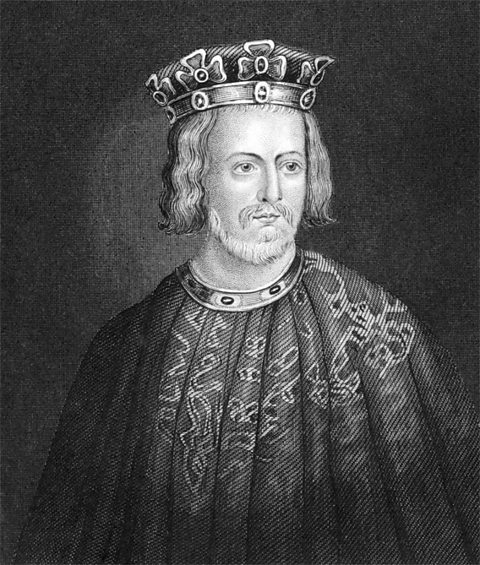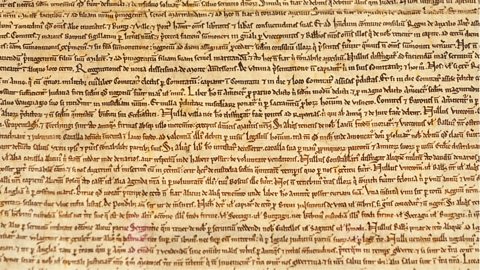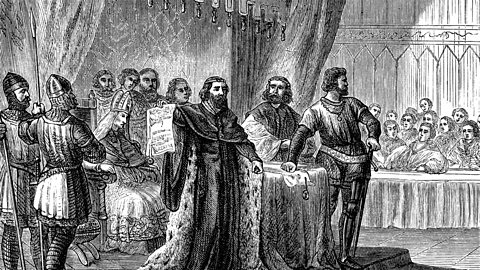Key points
- King John ruled England at a difficult time. He faced wars with France, a shortage of money and clashes with powerful English baronA member of the nobility, the social class ranked just below royalty..
- The barons became increasingly angry with John and eventually forced him to agree to changes in how England worked, written down in the Magna Carta.
- The Magna Carta is seen as the basis of many English laws and helped to influence the US constitution, which was written over 500 years later.
Video about King John and the Magna Carta
Narrator:
King John was king of England from 1199 to 1216. He is often remembered as a cruel and power-hungry king whose reign ended in the middle of a disastrous civil war with the barons of England. Stories written after his reign helped create this view. Shakespeare wrote a play in the 16th century where the character of King John was weak and murderous.
Tales of the outlaw Robin Hood also feature John as the villain who treats his people terribly. The negative view of King John can be traced back to the writings of medieval monks and other religious writers. They frequently wrote that he was an evil man, but they may have had a reason to try to paint this picture of him. John tightly controlled the Church and had fallen out with its leader, the Pope.
To try to keep the peace with rebellious barons and landowners, King John agreed to the Magna Carta in 1215. It was the first written document that established the rule of law and limited the king's power and allowed the wealthy landowners to have a say on new taxes.
However, John once again found himself at odds with the country when he broke the terms of the agreement. Today, the Magna Carta is viewed as one of the first steps towards democracy and some historians say he was wrong to break it.
But at the time, it might not have been seen as such an important document. John may simply have seen it as a temporary agreement that was meant to prevent a war. Also, the barons may have made deliberately extreme demands to provoke John to break the agreement, giving them a reason to go to war to try to seize his power.
From a military perspective, John is frequently viewed as a cowardly king who was reluctant to engage in open battles with his enemies. But many other leaders of the time tried to avoid this type of fighting.
Many historians point to John's successes at attacking towns and castles in France and England as a sign of his military skill. One historian even refers to his siege of Rochester Castle in 1215 as the greatest operation in England up to that time.
King John was certainly a tough and violent king, but his portrait as a cowardly and evil man has as much to do with those that wrote about him as it does with his actions.
Succeeding Richard I

John was crowned King of England in 1199. Richard I had died without any legitimateA legal term referring to a child born to parents who are married. heirA person in line to inherit something, for example, the heir to the throne is the next in line to be king or queen. , so John inherited the throne as Richardās only surviving brother.
When Richard was king, he had spent a significant amount of time and money fighting wars against France and going on CrusadesMilitary campaigns undertaken by Christians who believed that it was possible for them to 'reclaim' the Holy Land for Christianity from Islam. Muslims who lived in the Holy Land regarded the arrival of these Christian soldiers as an invasion.. On his return from fighting in the Crusades he was captured and held to ransom in what is now modern-day Germany by Henry VI, the Holy Roman Emperor. He was released once this was paid in 1194, which further affected England's finances. During Richardās time as a captive, John worked with King Philip II of France to try and seize the throne of England. This was unsuccessful but Richard and John made peace with each other on Richardās return to England.
During his reign, which lasted just under ten years, Richard had spent only six months in England. Fighting in the Crusades had been expensive, and England was heavily in debt. King Johnās reign has often been criticised, but he had to manage clashes with the Pope, France and his own barons. He had to deal with all these problems without the finances he needed to successfully manage them. John undoubtedly made some mistakes during his reign, but he did inherit several challenges on taking over from Richard I.

How did John come to be king?
Richard had no legitimate children, so declared he wanted John to succeed him. Richardās nephew, Arthur, also claimed the throne, as Richard had once named him as his heir, but he was only 12 years old at the time of his uncleās death. Arthur had support from French nobility for his claim. In 1203 Arthur was imprisoned on Johnās orders and disappeared. It is widely believed that John ordered Arthur to be killed, or perhaps even murdered his nephew himself.
King John's problems
Tensions with the Church
John had a dispute with the church over the appointment of a new Archbishop of CanterburyThe most senior bishop in England. in 1207. Johnās preferred appointment was ignored by the Pope, who was the head of the Catholic Church. John refused to allow the Popeās appointed archbishop, Stephen Langton, to enter England. This resulted in the Pope removing the rights of priests and bishops to conduct church services in England. Langton was eventually allowed to come to England in 1213, and worked with barons in opposing John, leading to the creation of the Magna Carta in 1215.
Battles with France
King John fought several battles with King Philip II over land in France. When he came to the throne, England controlled large amounts of territoryAn area of land controlled by a leader or state. in France. However John gradually lost this, including NormandyA region in the north of France. in 1204. This failure damaged Johnās reputation. He was nicknamed āsoftswordā due to the perception that his military leadership was so weak.
To try and win Normandy back, John needed to raise money. To do this, he increased taxes on the nobilityA class of people just below the king in rank and social status. They often controlled a large area of land which helped give them power and wealth.. Despite several attempts to reclaim Normandy, John never succeeded and the failure of his campaign in the 1214 Battle of Bouvines led to further criticism from barons in England. Some barons who refused to pay taxes were imprisoned, along with other members of their families.
Key events in King John's reign
The Magna Carta

In May 1215, a group of baronA member of the nobility, the social class ranked just below royalty. formed an army in the north of England and travelled south towards London. John had no choice but to offer them talks about changes to the way the country was ruled. He met with the barons at Runnymede, just outside London.
King John and the barons came to an agreement that would take some power away from the king and mean he would have to work more with the barons. This agreement was the Magna Carta, which means āGreat Charterā in Latin. It contained a total of 63 different clauses, setting out rules concerning land ownership, taxes and peopleās legal rights.
Some of the main points were:
- Someone accused of a crime could not be imprisoned or punished without having a fair trial first.
- The king could not raise new taxes unless he had the agreement of the barons.
- A council of 25 barons was set up to ensure the king followed the rules the charter put in place.


How did King John agree to the Magna Carta?
It is often said that King John 'signed' the Magna Carta, but according to the modern definition of the word āsignā, writing oneās name or signature, technically he did not. Instead, he agreed to it by putting his wax seal at the bottom, which was the medieval equivalent of a signature. The medieval definition of the word āsignā generally included agreeing to something by putting a wax seal as a signature, which is why many people tend to say now that King John āsignedā the Magna Carta.
The consequences of the Magna Carta
Short term
The Magna Carta was designed as a peace agreement between King John and the barons. It failed to achieve this, and the two sides were at war with each other within three months of it being signed. Historians believe that both sides were unhappy with the 1215 agreement and probably had no intention of sticking to its terms.
John died in 1216 and was succeeded by his son, Henry III, who was nine years old. The Magna Carta was changed and amended, with a final version being agreed and signed with the barons in 1225.
Long term
People have referred back to the Magna Carta at different points in history and some sections of it are still relevant to English law today. The Magna Carta was quoted during the events leading up to the English Civil Wars by those who insisted that citizens should have rights against a powerful ruler. It was also used as a basis for parts of the US constitution in 1788.
The right to a fair trail by jury was outlined in clause 39 of the Magna Carta and is still an important right today. However many rules from the Magna Carta, such as a ban on certain fishing methods and requirements relating to the clothing of monks, are not relevant today. There are four remaining copies of the original Magna Carta document. Two are held by the British library, one is at Salisbury Cathedral and one at Lincoln Cathedral.
Activity - Put the events in order
How do historians view King John?
In the years following his rule, John was portrayed as being greedy and selfish. Matthew Paris was a 13th century who was brutal in his criticism of John, saying of his death: āHell itself is made fouler by the presence of John'.
This perception was reinforced by William Shakespeareās play āKing Johnā, which suggested that John had stolen the throne from his nephew and was a weak king. In Disneyās 1973 animated film, Robin Hood, King John is shown as being obsessed with money and power.
Modern historians have re-evaluated Johnās rule. Some have praised him for his attempts to make reforms and suggested that he made the best of the problems he faced, arguing that he was in no position to fight a successful war in France. They have also argued that John was unfairly judged by chroniclers in the Middle Ages. Many of these chroniclers, including Matthew Paris, were also monks, and so they may have been biased against John because of the tensions between him and the Church.
Historian W.L. Warren, in his biography of John, said: āA peace policy at the beginning of the new reign was closer to necessity even than to prudenceā¦ Johnās mustering of forces in 1199 was impressive.ā
Many historians now believe that John had strengths and weaknesses as a king. It is their role to evaluate the evidence available to come up with their own interpretation of his reign.
Activity - What do the sources tell us?
John was a tyrant rather than a king, an oppressor of his own peopleā¦ owing to his idleness, he had lost Normandy and many other of his territories, and moreover was eager to lose or destroy the kingdom of England; and he was an insatiable extorter of money, and an invader and destroyer of the possessions of his own countrymen.
Matthew Paris was a monk and chronicler who was born c.1200 and died in 1259. He wrote the above quotation in his history of England, Historia Anglorum.
Questions
- What do you think Matthew Paris thinks of King John?
- Why might he have this view?
- Why is his work significant?
- Paris clearly disapproves of Johnās rule, describing him as a ātyrantā and criticising him for being idle, losing land and wasting money.
- Paris was a monk, so may have been angry about Johnās decisions around the church. He is also on the side of the Barons when he writes about Magna Carta. In his writing, Parisā personal opinion of John heavily influence his writing.
- Paris was a chronicler, writing shortly after Johnās death. His work is a key influence for other historians and writers when they make their judgment on Johnās reign.
If John is guilty of cruelty, then what of Richard I in 1191 when, following a dispute about the terms upon which Acre had been surrendered, he ordered the killing of 2,700 Muslim prisoners? What of Henry V, who during the battle of Agincourt in 1415 ordered the killing of several thousand French prisoners?
Graham E. Seel is a modern historian who wrote the above quotation in his 2012 book King John: An Underrated King.
Questions
- How does Graham E. Seel defend King John?
- Why do historians need to study a range of sources before judging King John?
- Seel argues that while John may have acted in a cruel way, it was no worse than the behaviour of other medieval kings. He argues that King John has been judged unfairly in comparison to others.
- There are contrasting views in evidence about King John. Seel argues he has been harshly judged, and did a good job in the circumstances he faced when he became king. Middle ages chroniclers argue John was a cruel and weak leader, who damaged England by losing land to France and backing down to the Barons. Historians need to consider the views presented in a range of sources to come to a judgment on his rule.
Test your knowledge
Play the History Detectives game! gamePlay the History Detectives game!
Analyse and evaluate evidence to uncover some of historyās burning questions in this game.
